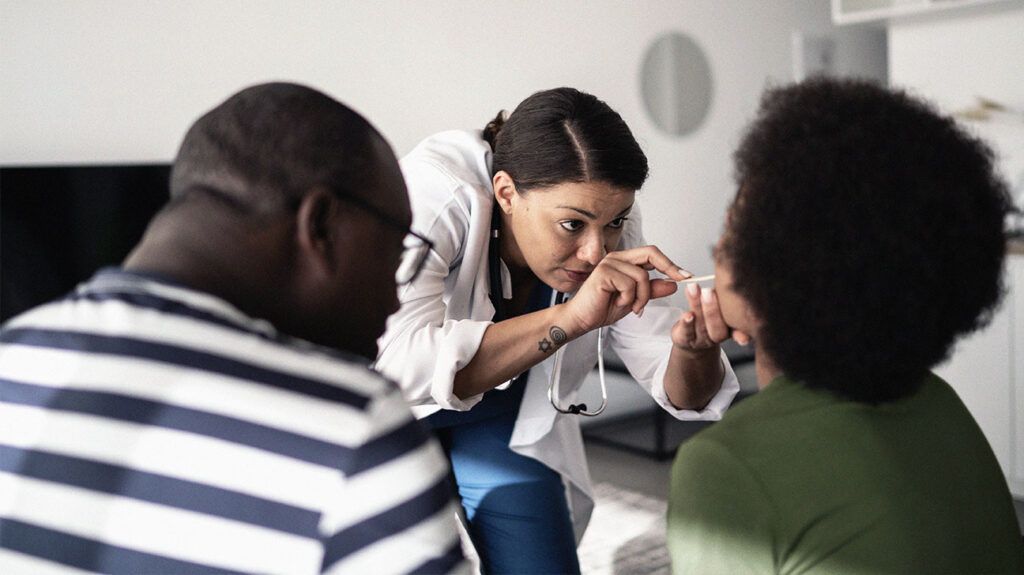Infectious mononucleosis, or mono, also known as glandular fever, is a common viral infection in children and teenagers. The Epstein-Barr virus (EBV) typically causes mono by spreading through saliva and close contact with others who have acquired the virus.
Mono can cause symptoms such as a fever, sore throat, and fatigue. A doctor can recommend treatments to help ease symptoms while the child recovers. Younger children may not experience symptoms.
Read on to learn more about the symptoms and causes of mono in children. This article also looks at treatment options, diagnosis, prevention, and more.

Symptoms of mono can include:
- fever
- a sore throat
- extreme fatigue
- swollen lymph nodes in the neck, groin, and armpits
- headache
- body aches
Mono can also cause a swollen spleen and liver.
These symptoms often develop around
Symptoms usually last 2–4 weeks, though fatigue can last several more weeks. In some cases, symptoms may persist longer.
Learn more about how long mono can last.
EBV is the
EBV usually spreads through bodily fluids, most commonly saliva. It can also spread through other bodily fluids, blood transfusions, and organ transplantation.
It may also spread through the following methods:
- oral contact with toys that other children have drooled on
- using the same cups, cutlery, or toothbrushes
- sharing food and drinks
EBV, which causes mono in most cases, is highly contagious at any age. During primary infection — the first time a person acquires EBV — the virus can spread between people for several
The virus remains in the body after mono passes. Even though it is inactive, or latent, it can become active again and spread to others.
Learn more about how long mono is contagious.
According to Nationwide Children’s, diagnosing mono can involve:
- performing a physical examination
- taking a full medical history
- ordering blood tests
Other blood tests show a range of features relating to mono,
- an increased number of white blood cells
- white blood cells that look unusual under a microscope
- fewer platelets in the blood than usual
- changes in liver function
Doctors sometimes use the mononuclear spot test, which they call a monospot test, to diagnose mono. This gives more precise results. However, this may not be reliable in children under 4 years of age, according to a
Mono will typically resolve on its own within a few weeks.
Some measures can help a child feel more comfortable while they recover. Remedies that may help include:
- pain relief medication that is safe for children, such as acetaminophen or ibuprofen
- drinking plenty of liquids
- getting plenty of rest
If a child has inflamed tonsils that are blocking the breathing passages, a doctor may prescribe corticosteroids to reduce swelling.
It is also important to prevent the child from engaging in contact sports or rough play if they show signs of spleen swelling. Violent contact with a swollen spleen
Most people with mono get better within
Some children feel fatigued for several weeks beyond this period, and some may experience mono-related fatigue for more than 6 months.
Although there is no vaccine against mono, various steps can help reduce the risk of EBV infection and mono. These
- not sharing toothbrushes or utensils
- cleaning children’s toys if they are sharing them
- avoiding contact with anybody who has mono
According to the
Mono is most common in children and young adults between 15 and 24 years of age, according to a
Below are answers to common questions about mono.
Can a child go to school with mono?
According to the United Kingdom’s National Health Service (NHS), children with mono need to stay home from school until they start to feel better.
However, it is important to follow the individual school’s guidelines for how long they require children to stay off school after experiencing an illness such as a viral infection.
A
What is the first mono symptom?
Mono
What are the stages of mono?
Mono goes through an incubation stage of
Mono in children usually occurs due to the Epstein-Barr virus (EBV). Symptoms can include a fever, fatigue, a sore throat, and swollen glands. It is particularly common among teenagers.
Although there is no specific treatment for mono, it may resolve on its own within 2–4 weeks. Pain relief medication, getting plenty of fluids, and resting can help manage symptoms.
